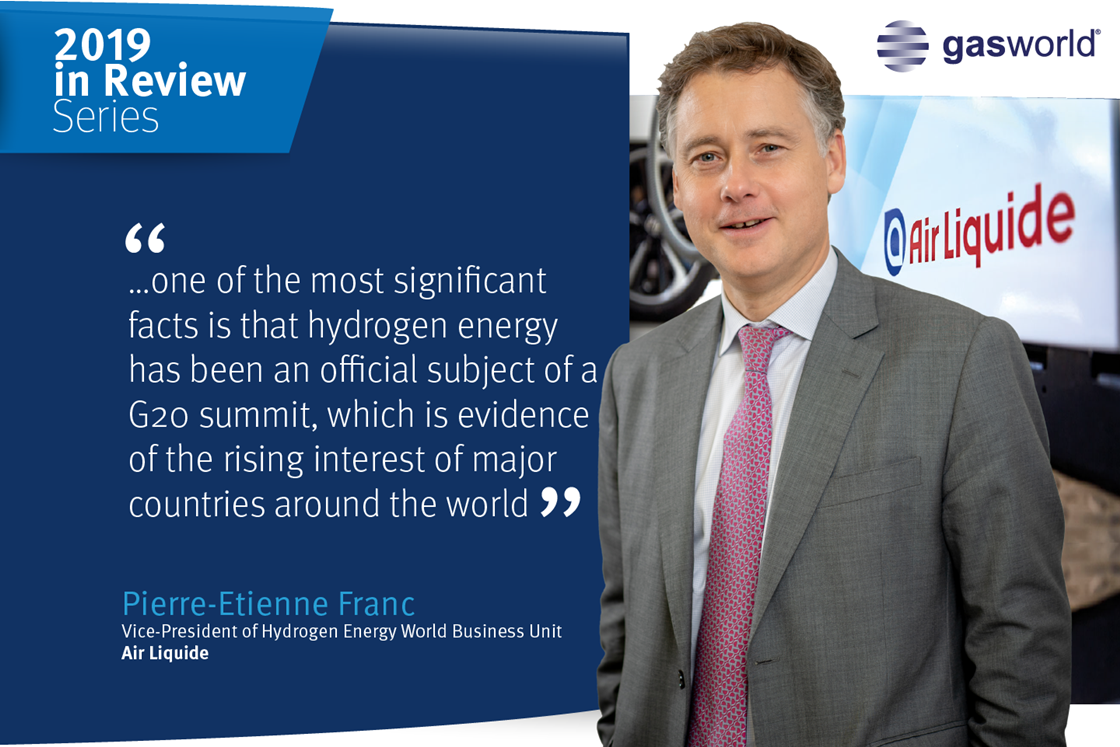
The French industrial gas giant is never far from the headlines when it comes to hydrogen, making several announcements in 2019 as part of its commitment to the clean energy.
From production and storage, to supply chain and into applications, Air Liquide has a ubiquitous presence in the global hydrogen economy, and Pierre-Etienne Franc, Vice-President of Air Liquide’s Hydrogen Energy World Business Unit, tells us more about the exciting things that Air Liquide has been involved in this year.
Gasworld (GW): What a year 2019 has been for hydrogen! Tell us about some exciting hydrogen-related projects Air Liquide has been involved in?
Pierre-Etienne Franc (PF): Many exciting things have happened for hydrogen this year!
In North America, Air Liquide has announced three major projects:
- The group has made a strategic transaction through the acquisition of a stake in the Canadian company Hydrogenics Corporation, a leader in electrolysis hydrogen production equipment and fuel cells, for an amount of $20.5m. Since then, Hydrogenics has been acquired by Cummins and Air Liquide has maintained its strategic stake in Hydrogenics.
- In Becancour (Québec), Air Liquide has started to build the biggest PEM electrolyser in the world: a 20MW electrolyser producing green hydrogen mainly for industry customers, but also for mobility.
- Air Liquide also announced it will produce renewable liquid hydrogen on a plant to be located in North Las Vegas, Nevada. Hydrogen will be produced in part from renewable natural gas (RNG) upgraded from biogas using our advanced separation membrane technology. This large-scale project will include production of 30 tonnes of liquid hydrogen per day. This will increase the hydrogen supply to the region and enable the market in California to continue its development towards an expected 200 stations by 2025. To this day, there are almost 7,900 hydrogen cars in California.
Asia keeps being a very dynamic market for Air Liquide. In China, we have signed several agreements to promote hydrogen energy and make plans on the development of hydrogen energy infrastructure and hydrogen fuel cell vehicles, in particular with Yankuang, Houpu, a leader in the production and construction of natural gas refilling stations on the Chinese market, and with Sinopec, the largest refining, and the second largest chemical and fuel retailer company in the world with a network of more than 30,000 retail stations.
Recently, Air Liquide has also opened several hydrogen refuelling stations (HRS) in Asia: three these past few weeks in the Shanghai area, three in Japan and one in South Korea.
Air Liquide also participated in the creation of a joint venture in South Korea between 13 companies from the private sector, working towards the deployment of 100 HRS nationwide by 2022.
In Europe, Germany is making huge progress towards its goal of operating, through the H2 Mobility consortium, of which Air Liquide is an active partner, 100 hydrogen stations in 2020. By November 2019, there were already close to 80 HRS operating in the country!
In France, Air Liquide has announced it is working on a project that aims at producing green hydrogen on an industrial scale. To that effect, a Memorandum of Understanding (MoU) has been signed by Air Liquide, ENGIE and the DLVA agglomeration that will make it possible to develop and validate the technical and economical conditions for the production of 1,300 GWh of solar electricity – which is equivalent to the annual residential consumption of about 450,000 people – together with the production of renewable hydrogen on an industrial scale through water electrolysis.
GW: What changes have you seen within the hydrogen ecosystem and community in the past year?
PF: What we observe is both a shaping and scaling up of the hydrogen ecosystem. Several new projects of an industrial size, such as our projects in Canada and in France, have been announced during 2019.
Also, the heavy-duty industry has seen major players joining forces, such as Cummins with Hydrogenics, but also CNH and Nikola in September.
Another clear sign of this momentum is the rising number of companies joining the ranks of the Hydrogen Council, which Air Liquide helped create in 2017 in order to promote hydrogen as a key part of the energy transition.
More than 60 major industrial companies are now members of the Hydrogen Council, compared to only 13 when it was founded about two years ago. That bodes well for the continuing development of hydrogen.
But one of the most significant facts is that hydrogen energy has been an official subject of a G20 summit, which is evidence of the rising interest of major countries around the world.
This has allowed to greatly increase the visibility and traction of Hydrogen on a world scale. The G20 Ministerial on Energy Transitions and Global Environment for Sustainable Growth published a communique pleading to “step up existing international efforts to unlock the potential of hydrogen as a clean, reliable and secure source of energy including cooperation in research and development, evaluating hydrogen’s technical and economic potential, cost reduction pathways and addressing the various challenges including regulations and standards.”
GW: Finally, if you had one thing on your bucket list for the gases industry, what would it be and why?
PF: A critical need is the right policy support: regulatory frameworks are needed to promote a reduction of carbon emissions across the transport, heating, industry and power sectors.
We are at a switching point regarding the production of green hydrogen at a massive scale and that is one of the most important things we should push forward.
Such large projects will be able to lower the price of green hydrogen to make it more affordable and most of all competitive compared to fossil-based solutions!
The 2019 in Review Series continues tomorrow with Ashley Madray, Gas Innovations’ Vice-President.
